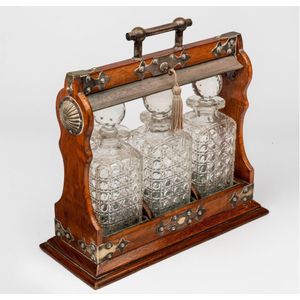Oak Tantalus with Crystal Decanters and Silver Plate Mounting
You must be a subscriber, and be logged in to view price and dealer details.
Subscribe Now to view actual auction price for this item
When you subscribe, you have the option of setting the currency in which to display prices to $Au, $US, $NZ or Stg.
- Oak - Native to Europe and England, oak has been used for joinery, furniture and building since the beginning of the medieval civilisation. It is a pale yellow in colour when freshly cut and darkens with age to a mid brown colour.
Oak as a furniture timber was superceded by walnut in the 17th century, and in the 18th century by mahogany,
Semi-fossilised bog oak is black in colour, and is found in peat bogs where the trees have fallen and been preserved from decay by the bog. It is used for jewellery and small carved trinkets.
Pollard oak is taken from an oak that has been regularly pollarded, that is the upper branches have been removed at the top of the trunk, result that new branches would appear, and over time the top would become ball-like. . When harvested and sawn, the timber displays a continuous surface of knotty circles. The timber was scarce and expensive and was used in more expensive pieces of furniture in the Regency and Victorian periods. - Tantalus - A tantalus is a container for holding two or three glass or crystal bottles of alchoholic drinks. A tantalus may take various forms, the most common being made from silver, silver plate or wood with the three bottles in a circle or two bottles in line with a central handle. A larger version has three bottles in a line with two end supports and a horizontal top and handle. To prevent unauthorised access, some tantalus have a locking mecahnism that prevents the bottles and stoppers being removed from the bottles when secured.
A box tantalus, as the name implies is an elaborate wooden box made of a fancy timber such as coramandel, with divisions for the bottles and a lockable lid. Some of these type are designed for liquers and include the liquer glasses set into fitted holders. - Circa - A Latin term meaning 'about', often used in the antique trade to give an approximate date for the piece, usually considered to be five years on either side of the circa year. Thus, circa 1900 means the piece was made about 1900, probably between 1895 and 1905. The expression is sometimes abbreviated to c.1900.
This item has been included into following indexes:
- tantalus (decanter sets)
Visually similar items

Hermes, cream purse handbag, c. 1960s, box calfskin leather with single top handle and braided gold hardware, scalloped envelope flap with hook fastening, stamped 'Hermes Paris, height 19 cm width 25 cm

Handmade silver, garnet and peridot earrings, unmarked but tested as silver

A Mark Douglas Design wrought iron hall table with glass top, circa 1996. 92 cm high, 159 cm wide, 48 cm deep.

Two small Royal Doulton figurines, Goody Two Shoes & Wendy
